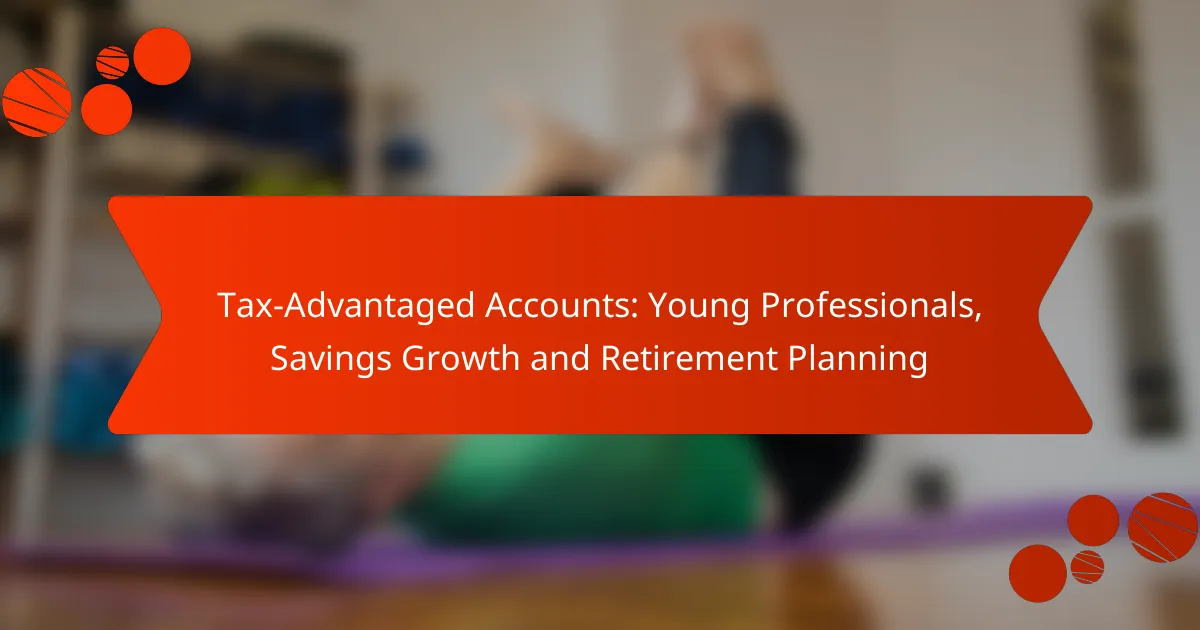For young professionals, tax-advantaged accounts are essential tools for building a secure financial future. By utilizing options like 401(k)s and IRAs, individuals can enjoy tax-free growth and strategically reduce their taxable income, making retirement savings more effective. These accounts not only facilitate long-term investment growth but also play a crucial role in effective retirement planning.

How can young professionals benefit from tax-advantaged accounts?
Young professionals can significantly enhance their financial future by utilizing tax-advantaged accounts, which allow for tax-free growth and withdrawals under certain conditions. These accounts, such as 401(k)s and IRAs, provide opportunities to save for retirement while minimizing tax liabilities.
Increased savings growth
Tax-advantaged accounts promote increased savings growth by allowing investments to grow without being taxed annually. For example, contributions to a 401(k) can reduce taxable income, enabling individuals to invest more upfront.
Additionally, the power of compound interest means that the earlier young professionals start contributing, the more their savings can grow over time. Even small, consistent contributions can lead to substantial growth, especially when invested wisely.
Tax-free withdrawals in retirement
One of the key benefits of tax-advantaged accounts is the ability to make tax-free withdrawals during retirement, particularly with Roth IRAs. This means that any growth on investments is not subject to taxes when funds are withdrawn after a certain age, typically 59½.
Understanding the rules surrounding these withdrawals is crucial. For instance, Roth IRA contributions can be withdrawn at any time without penalty, while earnings may have restrictions, making it essential to plan accordingly.
Employer matching contributions
Many employers offer matching contributions to retirement accounts, which can significantly boost savings. For example, if an employer matches 50% of contributions up to a certain percentage of salary, employees effectively receive free money toward their retirement savings.
Young professionals should take full advantage of these matches by contributing at least enough to qualify. Failing to do so is akin to leaving money on the table, which can hinder long-term financial growth.

What types of tax-advantaged accounts are available?
Tax-advantaged accounts are financial tools that allow young professionals to save for retirement while reducing their taxable income. Common types include 401(k) plans, Roth IRAs, and Traditional IRAs, each with unique benefits and rules.
401(k) plans
A 401(k) plan is an employer-sponsored retirement savings account that allows employees to contribute a portion of their salary before taxes are deducted. Many employers offer matching contributions, which can significantly enhance savings over time.
Contributions to a 401(k) are typically limited to a certain annual amount, often in the range of $20,000 to $25,000, depending on age and regulations. Withdrawals made before age 59½ may incur penalties, making it important to plan for long-term savings.
Roth IRA
A Roth IRA is an individual retirement account that allows contributions with after-tax dollars, meaning withdrawals during retirement are tax-free. This account is particularly beneficial for young professionals who expect to be in a higher tax bracket later in their careers.
Annual contribution limits for a Roth IRA are generally around $6,000, with an additional catch-up contribution allowed for those over 50. Income limits apply, so it’s essential to check eligibility before opening an account.
Traditional IRA
A Traditional IRA allows individuals to contribute pre-tax income, reducing their taxable income for the year. Taxes are paid upon withdrawal, typically during retirement when individuals may be in a lower tax bracket.
Similar to Roth IRAs, the contribution limit for a Traditional IRA is usually about $6,000 annually, with catch-up provisions for older savers. It’s important to consider your current and expected future tax situations when choosing between a Traditional and Roth IRA.

How do tax-advantaged accounts enhance retirement planning?
Tax-advantaged accounts significantly enhance retirement planning by allowing individuals to save and invest money while minimizing tax liabilities. These accounts, such as 401(k)s and IRAs, provide opportunities for long-term growth and can lead to a more secure financial future.
Long-term investment growth
Tax-advantaged accounts facilitate long-term investment growth by enabling investments to compound without immediate tax implications. For instance, contributions to a traditional IRA can grow tax-deferred until withdrawal, allowing the investment to potentially increase in value over time without the drag of annual taxes.
Young professionals can benefit from starting early, as even small contributions can accumulate significantly due to compound interest. For example, investing $200 monthly at a 7% annual return could grow to over $100,000 in 30 years.
Tax deferral benefits
Tax deferral is a key advantage of tax-advantaged accounts, allowing individuals to postpone paying taxes on both contributions and investment gains. This can result in a larger account balance at retirement since the money that would have gone to taxes remains invested.
For example, in a 401(k), contributions are made pre-tax, reducing taxable income for the year. This can be particularly beneficial for young professionals who may be in a lower tax bracket now compared to retirement, when they might withdraw funds at a higher rate.
Retirement income strategies
Effective retirement income strategies often involve utilizing tax-advantaged accounts to maximize withdrawals while minimizing tax burdens. A common approach is to withdraw from taxable accounts first, allowing tax-deferred accounts to continue growing.
Additionally, individuals should consider the timing of withdrawals from different accounts. For instance, withdrawing from a Roth IRA can be tax-free, while traditional IRAs will incur taxes upon withdrawal. Planning these strategies can help ensure a steady income stream throughout retirement.

What are the contribution limits for tax-advantaged accounts?
Contribution limits for tax-advantaged accounts vary by account type and are set annually by the IRS. Understanding these limits is crucial for maximizing your savings growth and retirement planning.
401(k) contribution limits
For 2023, the contribution limit for a 401(k) plan is typically around $22,500 for individuals under 50 years old. Those aged 50 and above can contribute an additional catch-up amount, bringing their total to approximately $30,000.
Employers may also contribute to your 401(k), often matching a percentage of your contributions. This can significantly enhance your savings, so it’s wise to take full advantage of any employer match available.
Roth IRA contribution limits
The contribution limit for a Roth IRA in 2023 is generally $6,500 for individuals under 50 years old, with a catch-up contribution of $1,000 for those aged 50 and older. However, eligibility to contribute phases out at higher income levels, so be sure to check the IRS guidelines based on your modified adjusted gross income.
Roth IRAs offer tax-free growth and withdrawals in retirement, making them an attractive option for young professionals looking to maximize their long-term savings.
Traditional IRA contribution limits
The contribution limit for a Traditional IRA is the same as for a Roth IRA, set at $6,500 for those under 50 and $7,500 for those 50 and older in 2023. Contributions may be tax-deductible, depending on your income and whether you or your spouse are covered by a workplace retirement plan.
Consider your current tax situation when deciding between a Traditional IRA and a Roth IRA. If you expect to be in a higher tax bracket in retirement, a Roth IRA may be more beneficial, while a Traditional IRA could provide immediate tax relief.

How do young professionals choose the right account?
Young professionals can choose the right tax-advantaged account by assessing their financial goals, evaluating employer offerings, and understanding tax implications. Each of these factors plays a crucial role in maximizing savings growth and planning for retirement effectively.
Assessing financial goals
Identifying financial goals is the first step for young professionals when selecting a tax-advantaged account. Consider whether the primary aim is short-term savings, long-term retirement planning, or a combination of both. This clarity helps in choosing the most suitable account type, such as a 401(k) for retirement or a Health Savings Account (HSA) for medical expenses.
Setting specific, measurable goals can further refine choices. For instance, if a young professional aims to save for a home within five years, a high-yield savings account or a Roth IRA may be more appropriate than a traditional retirement account.
Evaluating employer offerings
Many employers provide tax-advantaged accounts, such as 401(k) plans, which often include matching contributions. Young professionals should carefully review these offerings, as employer matches can significantly enhance retirement savings. If an employer offers a match, contributing at least enough to receive the full match is generally advisable.
Additionally, some employers may offer flexible spending accounts (FSAs) or HSAs. Understanding the benefits and limitations of these accounts can help in making informed decisions that align with personal financial goals.
Understanding tax implications
Tax implications are a critical consideration when choosing a tax-advantaged account. Accounts like traditional IRAs and 401(k)s provide tax deductions on contributions, while Roth accounts offer tax-free withdrawals in retirement. Young professionals should evaluate their current tax bracket and expected future income to determine which type of account may be more beneficial.
It’s also essential to be aware of contribution limits and potential penalties for early withdrawals. For example, in the U.S., the contribution limit for 401(k) accounts is typically adjusted annually, and early withdrawals may incur taxes and penalties. Understanding these factors can prevent costly mistakes and enhance overall savings strategy.

What are the common mistakes to avoid with tax-advantaged accounts?
Young professionals often make several common mistakes with tax-advantaged accounts that can hinder their savings growth and retirement planning. Avoiding these pitfalls is crucial for maximizing the benefits of these accounts.
Neglecting employer match
One of the biggest mistakes is failing to take full advantage of employer matching contributions in retirement plans like a 401(k). If your employer offers a match, it’s essentially free money that can significantly boost your retirement savings.
To avoid this mistake, contribute at least enough to receive the full match. For example, if your employer matches 50% of your contributions up to 6% of your salary, aim to contribute at least 6% to maximize this benefit.
Over-contributing to accounts
Over-contributing to tax-advantaged accounts can lead to penalties and unnecessary tax implications. Each account type has specific contribution limits set by the IRS, and exceeding these limits can result in a 6% excise tax on the excess amount.
To prevent this, stay informed about the annual contribution limits for accounts like IRAs and 401(k)s. For instance, in 2023, the limit for 401(k) contributions is $22,500 for individuals under 50. Regularly check your contributions to ensure you remain within these limits.
Ignoring investment options
Many young professionals overlook the investment options available within their tax-advantaged accounts, which can lead to suboptimal growth. Each account typically offers a range of investment choices, from stocks and bonds to mutual funds.
To make the most of your accounts, review and select investments that align with your risk tolerance and financial goals. Consider diversifying your portfolio to balance risk and potential returns. Regularly reassess your investment choices to adapt to changing market conditions and personal circumstances.



